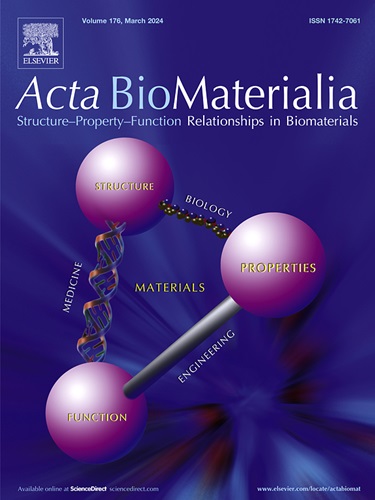Promotion of triple negative breast cancer immunotherapy by combining bioactive radicals with immune checkpoint blockade
IF 9.4
1区 医学
Q1 ENGINEERING, BIOMEDICAL
引用次数: 0
Abstract
Although immunotherapy has revolutionized clinical cancer treatment, the efficacy is limited due to the lack of tumor-associated antigens (TAAs) and the presence of compensatory immune checkpoints. To overcome the deficiency, a nano-system loaded with ozone and CD47 inhibitor RRx-001 is designed and synthesized. Upon irradiation, reactive oxygen species (ROS) generated from ozone reacts with nitric oxide (NO) metabolized from RRx-001 to form reactive nitrogen species (RNS), which presents a much stronger cell-killing ability than ROS. Molecular mechanism studies further reveal that RNS induce extensive immunogenic cell death (ICD). The released TAAs promote infiltration of cytotoxic T lymphocytes, which provides the basis for immune checkpoint blockade (ICB) therapy. Meanwhile, RRx-001 carried by the nanoparticles and the produced radicals repolarize M2-type tumor-associated macrophages (TAMs) into the anti-tumor M1-type, consequently reversing the immunosuppressive tumor microenvironment (TME). In a xenograft triple-negative breast cancer (TNBC) animal model, O3–001@lipo (liposome enwrapping O3 and RRx-001) plus irradiation shows a significant anti-tumor efficacy by improving cytotoxic lymphocyte infiltration and regulating immunosuppressive TME. In summary, the O3–001@lipo nano-system triggered by irradiation potently improves the efficacy of immunotherapy by introducing strong cytotoxic RNS, which not only enriches the toolbox of ICD inducer but also provides a strategy of treatment for immune deficient tumor.
Statement of significance
This study introduces a nano-system that leverages ozone and RRx-001 in the presence of X-ray irradiation to generate reactive nitrogen species, enhancing immunogenic cell death and promoting T-lymphocyte infiltration in triple-negative breast cancer, addressing a significant unmet need in the field.
The scientific contribution is the development of a clinically translatable nano-system that not only induces ICD but also reshapes the tumor microenvironment, which is expected to have a profound impact on the readership in pharmaceutics, material science, and nano-bio interaction, particularly for those interested in advanced immune therapy approaches.

将生物活性自由基与免疫检查点阻断相结合,促进三阴性乳腺癌免疫治疗
尽管免疫疗法已经彻底改变了临床癌症治疗,但由于缺乏肿瘤相关抗原(TAAs)和代偿性免疫检查点的存在,其疗效有限。为了克服这一缺陷,设计并合成了一种负载臭氧和CD47抑制剂RRx-001的纳米系统。辐照后,臭氧产生的活性氧(ROS)与RRx-001代谢的一氧化氮(NO)发生反应,形成活性氮(RNS),其杀伤细胞能力远强于ROS。分子机制研究进一步揭示了RNS诱导广泛免疫原性细胞死亡(ICD)。释放的TAAs促进细胞毒性T淋巴细胞的浸润,为免疫检查点阻断(ICB)治疗提供了基础。同时,纳米颗粒携带的RRx-001及其产生的自由基将m2型肿瘤相关巨噬细胞(tam)重新极化为抗肿瘤的m1型,从而逆转免疫抑制的肿瘤微环境(TME)。在异种移植三阴性乳腺癌(TNBC)动物模型中,O3-001@lipo(包裹O3和RRx-001的脂质体)加照射通过改善细胞毒性淋巴细胞浸润和调节免疫抑制TME显示出显著的抗肿瘤效果。综上所述,照射触发的O3-001@lipo纳米系统通过引入强细胞毒性RNS,有效地提高了免疫治疗的疗效,不仅丰富了ICD诱导剂的工具箱,而且为免疫缺陷肿瘤的治疗提供了一种策略。本研究介绍了一种纳米系统,该系统在x射线照射下利用臭氧和RRx-001产生活性氮,增强三阴性乳腺癌的免疫原性细胞死亡,促进t淋巴细胞浸润,解决了该领域尚未满足的重大需求。科学贡献在于开发了一种临床可翻译的纳米系统,该系统不仅可以诱导ICD,还可以重塑肿瘤微环境,预计将对制药、材料科学和纳米生物相互作用的读者产生深远的影响,特别是对那些对高级免疫治疗方法感兴趣的读者。
本文章由计算机程序翻译,如有差异,请以英文原文为准。
求助全文
约1分钟内获得全文
求助全文
来源期刊

Acta Biomaterialia
工程技术-材料科学:生物材料
CiteScore
16.80
自引率
3.10%
发文量
776
审稿时长
30 days
期刊介绍:
Acta Biomaterialia is a monthly peer-reviewed scientific journal published by Elsevier. The journal was established in January 2005. The editor-in-chief is W.R. Wagner (University of Pittsburgh). The journal covers research in biomaterials science, including the interrelationship of biomaterial structure and function from macroscale to nanoscale. Topical coverage includes biomedical and biocompatible materials.
 求助内容:
求助内容: 应助结果提醒方式:
应助结果提醒方式:


